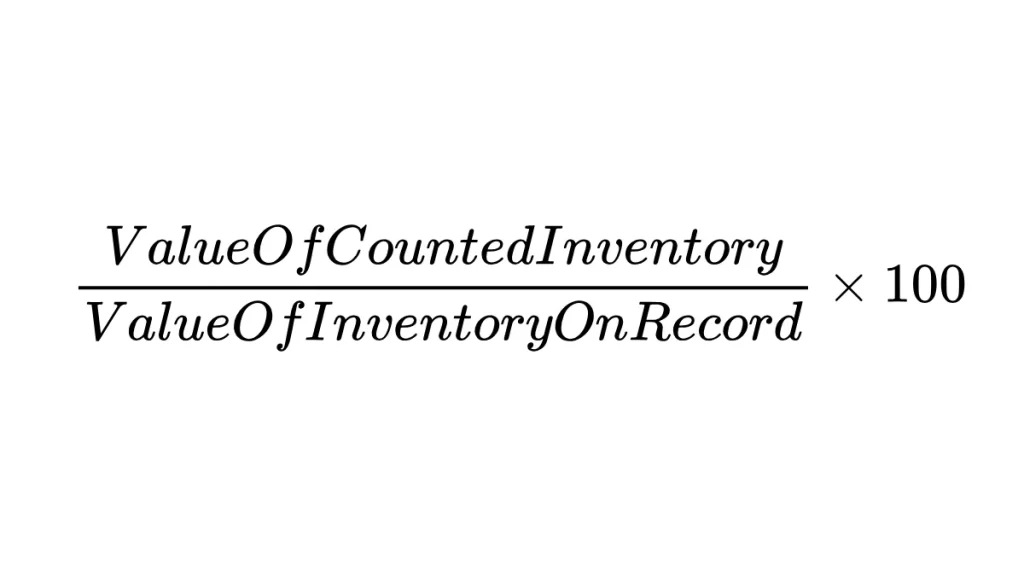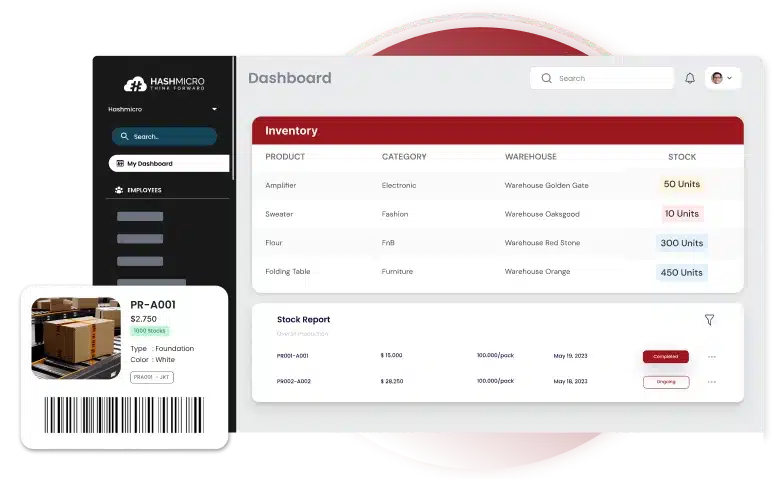Maintaining inventory accuracy is one of the biggest challenges I often see businesses face, especially retailers managing fast-moving products. When stock records don’t match the actual inventory, it can lead to stockouts, wasted warehouse space, and even lost revenue.
In fact, studies show that retailers typically only have accurate inventory information for about 35% of their items. This means that most of the time, there’s a serious disconnect between what’s on the shelves and what the system says is available.
In this article, I’ll walk you through why maintaining high inventory accuracy is crucial and share some practical tips and formulas to calculate it effectively. If you’re ready to automate your stock management and eliminate manual errors, try a free demo of HashMicro Inventory Software today.
Key Takeaways
|
What is Inventory Accuracy?
Inventory accuracy measures how closely recorded stock levels align with the actual physical count in a warehouse. For example, if records show 200 units but the real count is 150, the inventory accuracy rate is 75%.
Inaccurate inventory data can disrupt supply chains and lead to costly issues like stockouts or overselling. Businesses can improve accuracy by conducting routine stock counts, using barcode or RFID tracking, and adopting cloud-based inventory management systems.
Importance of Inventory Accuracy

Inventory accuracy plays a crucial role in the overall success of your business. Without it, managing stock becomes guesswork, and the team could end up facing operational challenges. Understanding its significance will help you avoid costly mistakes
Below are the benefits of inventory accuracy:
- Reduces overstocking and stockouts: Accurate inventory enables better purchasing decisions by maintaining optimal stock levels to meet demand without causing shortages or overstock.
- Lowers operating expenses: Accurate inventory records help identify slow-moving or dead stock, allowing businesses to cut carrying costs and optimize warehouse space.
- Enhances inventory management procedures: Accurate inventory counts enhance stock control, ensuring timely replenishment and preventing costly supply chain errors.
- Makes inventory forecasting easier: Accurate inventory data enables reliable forecasting, helping businesses avoid errors and make informed decisions on demand and replenishment.
- Reduces inventory errors like shrinkage and miscounts: Maintaining precise stock counts helps detect inconsistencies and shrinkage early, ensuring inventory records accurately reflect actual product conditions.
What is a Good Inventory Accuracy Rate?
With the rise of advanced system tools and RF-based transactions, companies now aim for high inventory accuracy. This metric study shows it exceeding 99.6% according to metrics studies. Top performers even reach 99.98%, making it a key inventory KPI across industries like manufacturing and retail.
However, traditional calculations often treat inventory accuracy as static, overlooking turnover frequency. To address this, many businesses with frequent stock movement now use revised formulas that account for total material flow instead of just on-hand balances.
Challenges in Achieving Consistent Inventory Accuracy

Stock discrepancies can lead to a variety of issues within your supply chain. Your website might display incorrect product availability, causing customers to place orders for items that aren’t actually in stock.
Before addressing solutions, it’s important to understand the root causes of these inaccuracies.
1. Undocumented inventory loss
Inventory loss, or shrinkage, happens when actual stock is lower than recorded due to theft, errors, or damage. Logging losses immediately helps maintain accurate records and prevents future discrepancies.
2. Errors in order fulfillment from suppliers
Supplier fulfillment mistakes can cause inventory inaccuracies and product unavailability if orders are recorded before arrival. Partnering with reliable suppliers and verifying orders through confirmation emails helps prevent costly errors.
3. Disorganized warehouses
Warehouse disorganization often leads to misplaced items and inaccurate counts, especially without an inventory management system. Maintaining organization through standardized labeling, uniform bins, and clear picker guidelines ensures accurate tracking and prevents stock losses.
4. Mismanaged returns
Poorly managed returns can create “ghost inventory,” where stock appears available but isn’t due to incorrect coding. Streamlining and automating the returns process, along with proper staff training, helps maintain accurate inventory records.
How to Calculate Inventory Accuracy
There are two commonly used methods to calculate inventory accuracy:
1. Physical Inventory Counting
Physical inventory counting, also known as inventory reconciliation, involves comparing the actual physical stock on hand with the recorded inventory data. This process helps identify discrepancies and understand their causes.
To perform this method, you conduct a physical count of all available inventory and compare it with the recorded numbers. The inventory accuracy rate can be calculated using the formula:
Inventory Accuracy Rate = (Counted Units / Units on Record) x 100

If the counts match, your inventory is accurate. If they don’t, there is a discrepancy that needs attention. To maintain accuracy, it’s recommended to perform weekly checks using this method, allowing you to consistently monitor and adjust your stock levels.
2. Inventory Valuation
This method is used in inventory accounting, where you calculate inventory accuracy by comparing the total value of the physical inventory on hand with the value recorded in your tracking system. Unlike physical counting, this approach doesn’t account for individual items.
The formula is:
Inventory Accuracy (Valuation Method) = (Value of Counted Inventory / Value of Inventory on Record) x 100

This method calculates the accuracy rate by comparing the total value of the physical inventory to the recorded value in your system. While it’s a quick way to assess inventory accuracy in terms of value, it doesn’t provide the detailed item-level insight that physical counting offers.
Tips to Improve Inventory Accuracy

Improving inventory accuracy starts with adopting best practices that enhance your stock management. By focusing on these best practices, you can ensure more reliable data and smoother processes.
Here are some key tips to help you maintain accurate inventory levels:
1. Regularly check your inventory
Maintaining inventory accuracy should be a priority. Conduct frequent inventory checks to ensure that your physical stock aligns with your recorded data. By performing these checks consistently, you reduce the risk of inaccuracies and can quickly address any discrepancies before they escalate.
To make regular inventory checks easier, you can utilize various tools, such as barcode scanning and RFID, which can be compiled into a central platform like inventory management software. Click on the pricing scheme banner below to explore more!
2. Implement a cycle counting system
Cycle counting involves periodically counting a subset of your inventory in specific locations on a scheduled basis. This method allows you to avoid the need for annual physical counts, focusing instead on regular checks of select items to ensure your inventory remains accurate throughout the year.
3. Enhance inventory security
Proper security measures are essential for safeguarding your inventory within the storage facility. By securing your stock, you can significantly reduce theft, ensuring that your inventory counts stay accurate since shrinkage will be minimized.
4. Opt for professional storage solutions
Instead of storing inventory in personal spaces, businesses should use professional warehouses to improve accuracy and efficiency. Combined with proper warehouse management, this approach ensures real-time inventory tracking and long-term cost savings.
5. Partner with a fulfillment company
Partnering with an e-commerce fulfillment provider streamlines storage, management, and shipping processes. They handle picking, packing, and warehousing, ensuring efficient inventory management without added workload.
6. Upgrade your inventory management system
A robust inventory management system drives sustainable growth by improving accuracy and control. Using advanced inventory management software with features like an inventory aging report helps manage aging stock efficiently, reduce waste, and enhance overall inventory performance.
7. Conduct frequent and random inventory checks
To improve accuracy and avoid issues, schedule frequent cycle counts. Randomized inventory checks help prevent unnoticed errors from accumulating, ensuring your records stay consistent and reducing the risk of inventory discrepancies.
Enhance Your Inventory Accuracy Seamlessly with HashMicro Inventory Software

Inventory accuracy means maintaining complete control over stock and operations to prevent costly errors and workflow disruptions. HashMicro Inventory Management Software automates stock movements, synchronizes real-time data, and ensures every item is accurately tracked from arrival to delivery.
HashMicro has these features to help you optimize your inventory:
- RFID Warehouse Rack Stock-In-Out Automation: This system automates the tracking of goods moving into and out of warehouse racks, ensuring real-time updates and reducing human errors.
- Cycle Counting: Implementing a cycle counting method ensures precise inventory levels without the need for a thorough physical count.
- Stock Forecasting: This method optimizes stock levels by forecasting future demand based on historical data and trends, preventing overstocking and understocking.
- OCR for Receiving: Converting text from physical papers into digital data during the receiving process ensures that inventory records correspond to actual stock.
- Stock Reservations and Reporting: This function monitors stock allocations before they are physically transported, assuring correct records of available stock and preventing double booking or miscounts.
- Fast Moving, Slow Moving, and Non-Moving Stock Analysis: Identifying things that move at different rates can help increase accuracy by concentrating efforts on closely monitoring fast-moving items while optimizing stock levels for slow or non-moving items.
“Inventory accuracy is the foundation of effective supply chain management. Without precise, real-time data, even the most advanced forecasting or automation tools will fail to deliver optimal results.”
— Angela Tan, Regional Manager
Conclusion
Inventory accuracy is essential for keeping your business functioning effectively. It guarantees that your physical inventory matches your records, which enables companies to avoid problems such as stockouts, overstocking, and costly errors.
HashMicro Inventory Management Software simplifies the procedure. It does more than just track your inventory; it provides real-time data, automates stock moves, and guarantees that everything is properly accounted for.
Whether you employ RFID tracking or cycle counting, you’ll always know what’s in your warehouse and where it’s going. With its simple connection and advanced functionality, maintaining your inventory becomes effortless.
Why not give HashMicro a try and book your free demo now? Confirm power lah!
Frequently Asked Questions About Inventory Accuracy
-
What is the standard benchmark for inventory accuracy?
For companies using SKUs and barcode scanning systems, the industry benchmark for inventory accuracy is typically 97% or higher. Falling below this percentage can negatively impact business operations.
-
Who is accountable for maintaining inventory accuracy?
Both internal and external teams share the responsibility for ensuring inventory accuracy. Internal audit teams, often made up of staff from different departments, conduct regular inventory checks to maintain accuracy and compliance.
-
What are the risks of inaccurate inventory records?
Inaccurate inventory data, often caused by human error or outdated systems, can lead to overstocking, understocking, and delayed order fulfillment. These issues can result in lost sales and higher operational costs.















